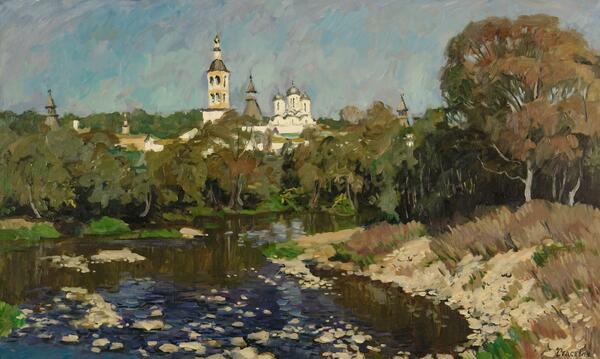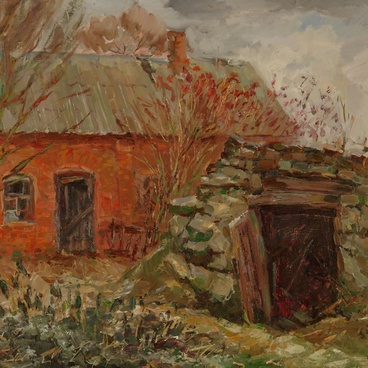Alexander Stasevich (1954–2010) is one of the representatives of the rich artistic life of Obninsk, a member of the Union of Artists of Russia. As a child, he moved with his parents to Obninsk, which became dear to him and which he never left. It was this town that became one of the main motives in the artist’s work, as well as his native village Spas-Zagorje, a picturesque place on the Protva River.
He was a student of the director of the Obninsk children’s art school, the famous local master Boris Shavanov. Many graduates of his school became artists and, remaining in the town of childhood, embodied the lyrical nature of the region in their work.
After graduating from the Moscow School of Industrial Art, Stasevich received the position of a graphic designer in Obninsk. Since 1976 he participated in numerous exhibitions, and devoted the last years of his life to easel painting. His paintings are kept in the galleries of Tarusa, Borovsk, Maloyaroslavets, in the Museum of the History of Obninsk and other collections.
The landscape ‘On the Bank of the Protva River’ from the collection of the Tarusa Art Gallery depicts a view of the Borovsk Monastery on a clear warm day. The Borovsky Monastery was founded in 1444 by Pafnutiy Borovsky. The architecture of its building dates back to the 16th-17th centuries. The monastery was a place of prayer for the great dukes. It is a center of attraction with a rich history, for pilgrims and tourists.
The harmonious coloring of the painting masterfully repeats natural colors. The artist reproduces the nature of the vegetation of the edge with strokes of different textures, achieving a three-dimensional image of trees. He pays great attention to details: the architecture of the monastery is clearly depicted, and the silhouette of its reflection in the river is outlined. The calm flow of transparent water is conveyed by the ripples of the river covered with water lilies.
His landscapes reflect the artist’s sincere love for his native land. They are lyrical and imbued with light. The artist’s subtle observation, the choice of subjects and the ability to very accurately reflect the state of nature at different times of the year evokes the association of his works with the key figures in the history of Russian school landscape.
He was a student of the director of the Obninsk children’s art school, the famous local master Boris Shavanov. Many graduates of his school became artists and, remaining in the town of childhood, embodied the lyrical nature of the region in their work.
After graduating from the Moscow School of Industrial Art, Stasevich received the position of a graphic designer in Obninsk. Since 1976 he participated in numerous exhibitions, and devoted the last years of his life to easel painting. His paintings are kept in the galleries of Tarusa, Borovsk, Maloyaroslavets, in the Museum of the History of Obninsk and other collections.
The landscape ‘On the Bank of the Protva River’ from the collection of the Tarusa Art Gallery depicts a view of the Borovsk Monastery on a clear warm day. The Borovsky Monastery was founded in 1444 by Pafnutiy Borovsky. The architecture of its building dates back to the 16th-17th centuries. The monastery was a place of prayer for the great dukes. It is a center of attraction with a rich history, for pilgrims and tourists.
The harmonious coloring of the painting masterfully repeats natural colors. The artist reproduces the nature of the vegetation of the edge with strokes of different textures, achieving a three-dimensional image of trees. He pays great attention to details: the architecture of the monastery is clearly depicted, and the silhouette of its reflection in the river is outlined. The calm flow of transparent water is conveyed by the ripples of the river covered with water lilies.
His landscapes reflect the artist’s sincere love for his native land. They are lyrical and imbued with light. The artist’s subtle observation, the choice of subjects and the ability to very accurately reflect the state of nature at different times of the year evokes the association of his works with the key figures in the history of Russian school landscape.



